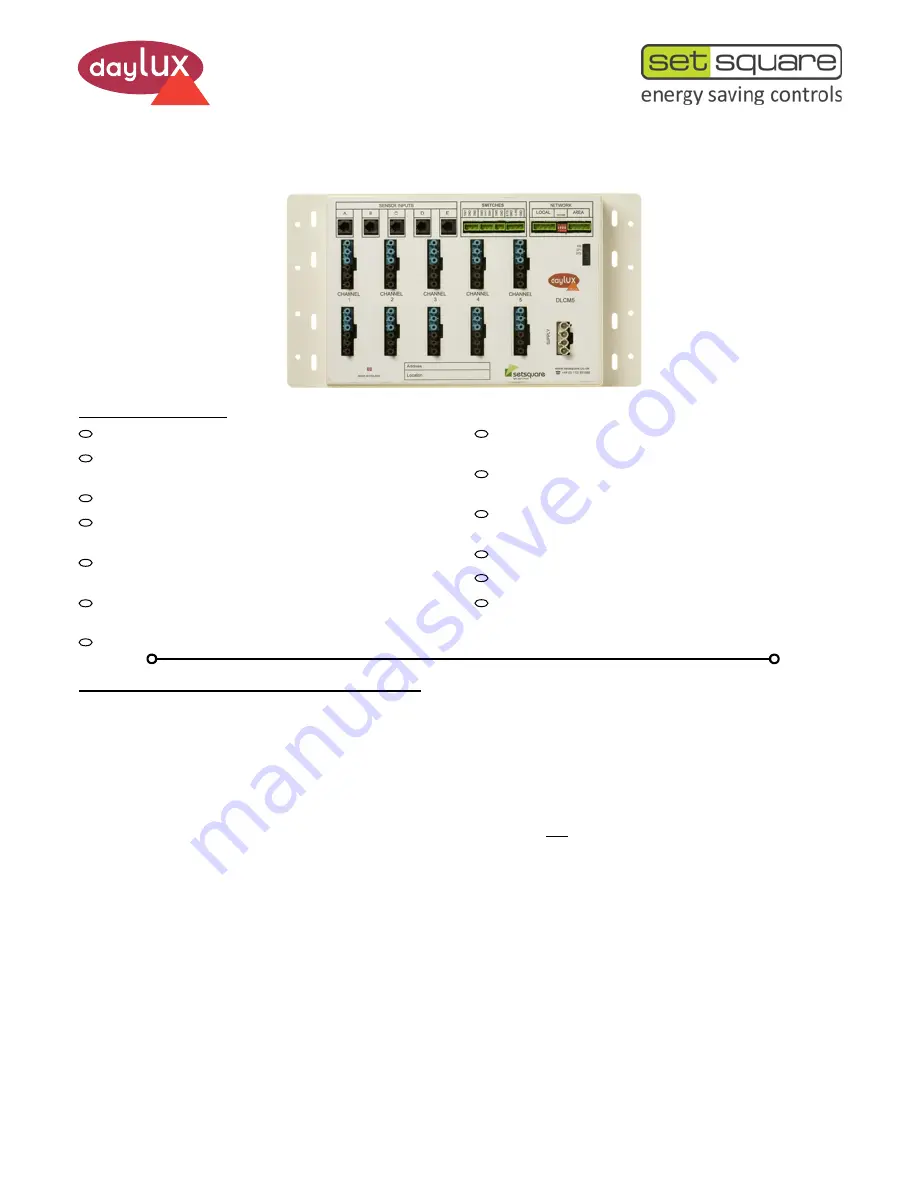
DLCS
SET-DLCM3,5 (A,D)
10 WAY PLUGGABLE LIGHTING CONTROL MODULE
1 of 4
PRODUCT FEATURES
BASIC USER GUIDE
SELF CONFIGURATION AND FACTORY DEFAULTS
The SET-DLCM 3 or 5 run through a unique, automatic, simply
intelligent self-configuration process once powered up. This allows a
system to be fully functional ‘out of the box’ without the need for initial
setup and programming. The self-configuration process is activated
every time the DLCM is powered up, until it has been either programmed
or settings have been changed/modified and stored.
How a system self configures is dependant on various factors.
Such as:-
Whether the SET-DLCM is either a 3 or 5 channel lighting control
module. If occupancy sensors are attached, how many and which input
port they are plugged into.
If light level sensors are attached, how many and which input port they
are plugged into.
If SET-DFP type faceplates are attached.
If more than one SET-DLCM or other ‘Output’ devices are networked
together.
The self configuration process is dependant on a set of preprogrammed
‘Factory Defaults’. These defaults are as follows:-
Occupancy Delay:
The SET-DLCM will switch its output channels off
after occupancy ceases. Time delay is 10 minutes by default.
Dimming Protocols:
SET-DLCM3-D and SET-DLCM5-D outputs are
DSI (default). SET-DLCM3-A and SET-DLCM5-A outputs are 1-10v
Analogue.
Dimming Channels:
Configure depending on which sensor inputs
light level sensors are plugged into. (See ‘Channel Self -Configuration
Table on page 3).
Network Control:
When multiple ‘Output’ devices are networked
(connected) together, how they configure will be dependant on
whether each output device has its own sensors or not. If sensors are
connected to only one output device ALL other output devices on that
network will mirror the output device with the sensors directly
connected to it. If sensor(s) are connected to multiple output devices,
then ALL output devices will operate independently for occupancy
and light level.
Please note: ALL commands and triggers from faceplates or switches
are broadcast across the network and ALL output devices will
respond.
3 or 5 Channel control and lighting distribution.
10 x Outputs to luminaries using industry standard
‘Wieland’ connectors.
Capable of Dimming and / or Switching from one unit.
All common dimming protocols supported (DSI, DALI
‘Broadcast’ and 1-10v Analogue).
Automatic light level dimming or switching (daylight linking).
Maintains a specific Lux level and saves energy.
Manual dimming or switching - via faceplates or momentary
switches for scene selection, off, raise and lower.
Presence and / or absence detection.
Unique automatic, simply intelligent self-configuration -
detects sensors and configures itself accordingly.
Programmable - allows the flexibility of re-configuration for
any future changes to the controlled area’s use.
Standalone or multiple, fully networked systems using
RS485 networking. Fully scalable.
Override facility.
Emergency Lighting test facility.
Easy integration with BMS (Building Management) and AV
(Audio/Visual) systems.
Presence/Absence:
The SET-DLCM’s can operate as either a presence
or absence detection system. In presence detection mode the lighting
will automatically switch on when someone enters an area where there
are occupancy detectors. In absence mode the lighting will only switch
on when someone operates a switch or scene button on a faceplate. The
lighting can also be manually turned off by the same switch or by the
‘Off’ button on a faceplate. By default, presence mode is set to ‘On’.
Scenes:
When a faceplate is on a system, scenes can be selected
by operating a ‘Scene’ button on the faceplate. If a light level sensor
is also on the system, the default ‘Scenes’ will be as follows:-
Scene 1 = Automatic (Daylight linked). Output Level = High
Scene 2 = Automatic (Daylight linked). Output Level = Low
Scene 3 = Manual (Fixed Output). Output Level = High
Scene 4 = Manual (Fixed Output). Output Level = Low
If a faceplate is fitted without any light level sensors, then Scene 1 &
2 are as per scenes 3 & 4 above.
Manually Changing Light Levels:
It is possible to manually adjust
light levels temporarily for your convenience by using the ‘Raise’ or






















